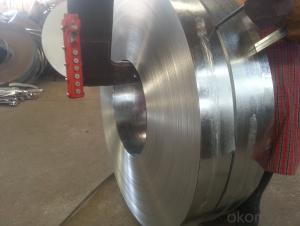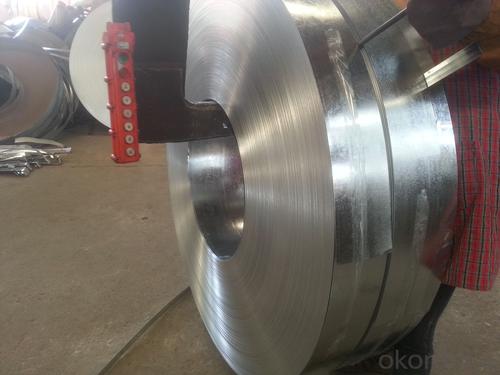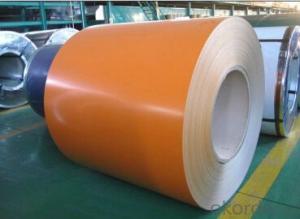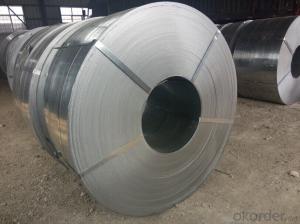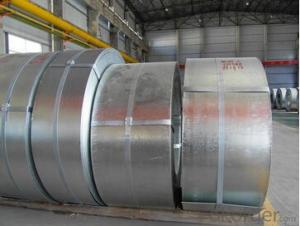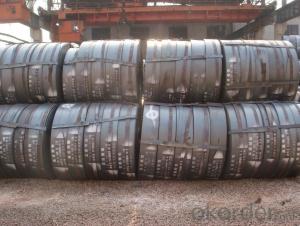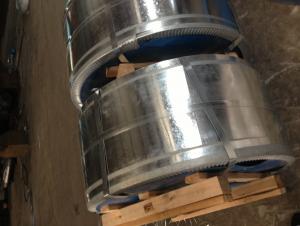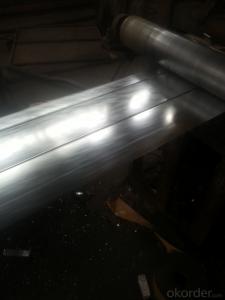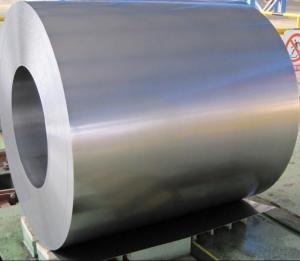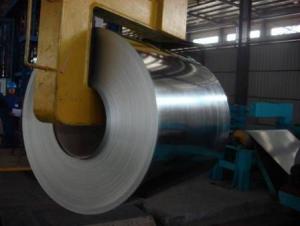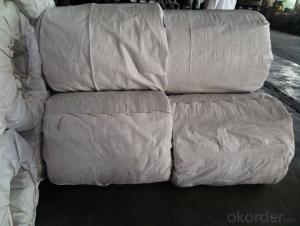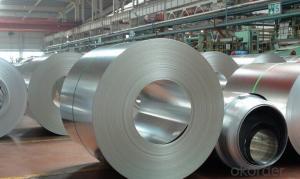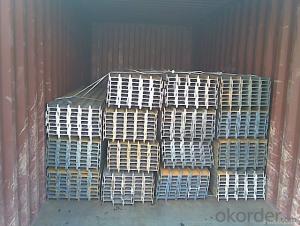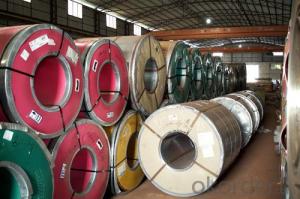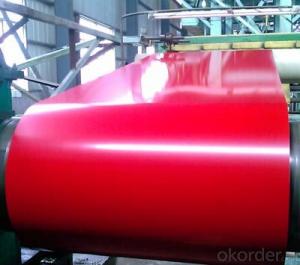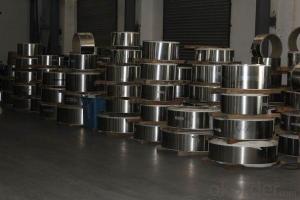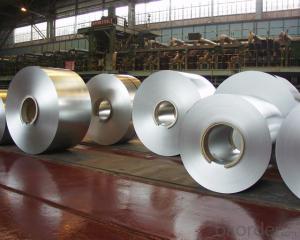Hot Dip Galvanized Slitted Steel Coils Hot sale
- Loading Port:
- Shanghai
- Payment Terms:
- TT OR LC
- Min Order Qty:
- 25 m.t.
- Supply Capability:
- 50000 m.t./month
OKorder Service Pledge
OKorder Financial Service
You Might Also Like
Product Description:
Hot Dipped Galvanized Steel Strips
Hot-dip galvanized steel strips are available with a pure zinc coating through the hot-dip galvanizing process. It offers the economy, strength and formability of steel combined with the corrosion resistance of zinc. The hot-dip process is the process by which steel gets coated in layers of zinc to protect against rust. It is especially useful for countless outdoor and industrial applications.
Product Description Of Hot Dipped Galvanized Steel Strips
Thickness | 0.18mm-3mm |
Width | less than 600mm |
Zinc Coating | 30-200g/m2 |
Internal Diameter | 508mm/610mm |
Coil Weight | less than 3MT |
Quality | commercial and structural quality |
Surface Treatment | regular & minimum spangle, zero spangle, oiled & dry, chromated , non-skin pass , skin pass |
Standard | JIS G 3302, ASTM A 653M, EN 10327 |
Steel Grade | SGCC, CS, FS, SS, LFQ, DX51D+Z , S280GD |
Technical Data Of Hot Dipped Galvanized Steel Strips
Chemical Composition | C | Si | Mn | P | S |
0.04-0.06% | 0.01-0.03% | 0.18-0.22% | 0.014-0.016% | 0.006%-0.009% |
Yield Strength | (Mpa) 280-320 |
Tensile Strength | (Mpa) 340-390 |
Elongation | 20%-30% |
Out-of-square | not exceed 1% Flatness |
Bow | 15mmmax |
Edge Wave | 9mmmax |
Centre Buckle | 8mmmax |
Bending At 180 Degree | No crack, purling and fraction |
Application Of Hot Dipped Galvanized Steel Strips
It can be widely used in transportation, light industry, civil usage and farming. It is also the perfect building material in construction for making roofing tile, steel profiles for wall partition, T-bar, studs, fireproof door, air conditioning duct and home appliance.
- Q: How are steel strips tested for quality and durability?
- Steel strips are tested for quality and durability through various methods that assess their strength, resistance to corrosion, and overall performance. One of the primary tests is the tensile test, which measures the strip's ability to resist forces and determine its yield strength, ultimate tensile strength, and elongation capacity. This test involves subjecting the steel strip to progressively increasing loads until it fractures, providing valuable information about its mechanical properties. Additionally, steel strips undergo hardness testing to evaluate their resistance to indentation or scratching. This test helps determine if the material meets the required hardness specifications for its intended application. Another crucial aspect of quality testing is the assessment of the strip's surface finish, where visual inspections and microscopic examinations are conducted to identify any defects, such as scratches, pits, or irregularities on the surface. To assess the durability and corrosion resistance of steel strips, they undergo corrosion testing. This involves exposing the strips to various corrosive environments, such as salt spray or acidic solutions, for a specific period. The samples are then examined for signs of corrosion, such as rust or pitting, to determine their resistance to deterioration. Moreover, steel strips can be subjected to impact testing to evaluate their toughness and ability to absorb energy during sudden loading. This test simulates real-world scenarios where the strip might encounter sudden shocks or impacts, ensuring its suitability for applications that require high impact resistance. In addition to these physical tests, steel strips may also undergo chemical analysis to determine their composition and ensure compliance with the required specifications. This analysis involves techniques such as spectroscopy or X-ray fluorescence to identify the presence and concentration of elements within the steel. Overall, the combination of mechanical, surface, corrosion, impact, and chemical tests allows manufacturers to thoroughly assess the quality and durability of steel strips, ensuring they meet the necessary standards and can perform reliably in their intended applications.
- Q: Are steel strips suitable for making automotive parts?
- Steel strips are well-suited for manufacturing automotive parts due to their various properties. Firstly, steel is renowned for its strength and durability, making it an essential choice for automotive components that must endure high levels of stress and impact. Moreover, steel strips can be easily manipulated into different shapes and sizes, facilitating the production of intricate automotive parts. The malleability of steel strips also allows for the formation of precise curves and angles, ensuring a perfect fit for automotive components. In addition, steel is relatively inexpensive compared to alternative materials, making it a cost-effective option for automotive manufacturers. Lastly, steel strips possess outstanding corrosion resistance properties, which is vital for automotive parts exposed to diverse weather conditions and road environments. All in all, steel strips offer a combination of strength, versatility, affordability, and corrosion resistance, making them highly suitable for automotive part production.
- Q: What are the safety protocols for handling steel strips in a warehouse?
- When handling steel strips in a warehouse, it is important to follow certain safety protocols to prevent accidents and injuries. These protocols include: 1. Personal Protective Equipment (PPE): All workers handling steel strips should wear appropriate PPE, including steel-toed boots, gloves, safety glasses, and hard hats. These protect against potential hazards such as falling objects, sharp edges, and heat. 2. Proper Lifting Techniques: When lifting steel strips, workers should use proper lifting techniques to avoid strains and other injuries. They should bend their knees, keep their back straight, and lift with their legs instead of their back. If the strips are too heavy, they should use lifting equipment such as cranes or forklifts. 3. Clear Communication: Clear communication is crucial in a warehouse setting. Workers should communicate with each other to coordinate movements, especially when handling large steel strips. This ensures everyone is aware of potential hazards and can work in a safe manner. 4. Secure Storage: Steel strips should be stored securely in designated areas to prevent them from falling or causing obstructions in walkways. Proper stacking techniques should be used, and heavy strips should be secured with straps or clamps to prevent them from toppling over. 5. Machinery Safety: If machinery is used to handle steel strips, workers should be trained on its safe operation and maintenance. Regular inspections and maintenance should be conducted to ensure the machinery is in proper working condition, and any malfunctions or damages should be reported and repaired promptly. 6. Adequate Lighting: Proper lighting is essential in a warehouse to ensure workers can see clearly and avoid potential hazards. Adequate lighting should be provided in all areas where steel strips are handled, including storage areas, loading docks, and walkways. 7. Regular Training: All workers involved in handling steel strips should receive regular training on safety protocols and procedures. This training should cover topics such as proper lifting techniques, PPE usage, emergency procedures, and safe operation of machinery. By following these safety protocols, the risk of accidents and injuries can be significantly reduced in a warehouse environment where steel strips are handled. It is crucial for management to enforce these protocols and provide a safe working environment for all employees.
- Q: What is the impact resistance of a steel strip?
- A steel strip's ability to withstand sudden forces or impacts without breaking or deforming is referred to as its impact resistance. Steel is renowned for its exceptional strength and toughness, making it highly resistant to impact. It has the capacity to absorb and distribute the energy from an impact throughout its structure, preventing the formation of cracks or fractures. The impact resistance of a steel strip can vary depending on several factors, including the steel grade, strip thickness, and alloy composition. Various steel types, such as stainless steel or carbon steel, may exhibit different levels of impact resistance. In order to ensure durability and longevity in various applications, steel strips are generally designed with high impact resistance. This quality makes them suitable for use in industries like construction, automotive, aerospace, and manufacturing, where they may encounter heavy loads, vibrations, or sudden impacts. To determine the impact resistance of a steel strip, different tests like Charpy or Izod impact tests can be performed. These tests involve striking a notched sample of the steel strip with a pendulum or hammer, and measuring the amount of energy absorbed before fracture. Overall, the impact resistance of a steel strip is a crucial characteristic that contributes to its overall strength and reliability in demanding environments.
- Q: Can steel strips be used in the production of electrical connectors?
- The utilization of steel strips in the manufacturing of electrical connectors is indeed possible. Due to its diverse properties, steel is frequently employed as a material in the production of electrical connectors. Connector bodies or conductive elements within the connectors often rely on steel strips. Electrical connectors derive several advantages from the use of steel. It is a robust and long-lasting material, offering exceptional mechanical strength and resistance to deformation. This ensures that the connectors can endure the challenges of usage and maintain a secure connection over time. Moreover, steel possesses excellent electrical conductivity, facilitating efficient transmission of electrical signals. Its high thermal conductivity aids in dissipating heat generated during electrical operations. As a result, steel strips are well-suited for use in electrical connectors, enabling effective transfer of electrical current and management of associated heat. Additionally, steel is readily available and cost-effective, making it an economical choice for connector production. It can be easily shaped, stamped, or machined to attain the desired form and features necessary for connectors. This adaptability allows for the production of a wide array of connector types and sizes to fulfill diverse electrical connection requirements. Nevertheless, it is important to note that specific applications may necessitate additional surface treatments or coatings for steel strips to prevent corrosion or enhance conductivity. Overall, steel strips are a dependable and extensively utilized material in the production of electrical connectors, owing to their strength, conductivity, and cost-effectiveness.
- Q: How are steel strips processed for recyclability?
- Steel strips can be processed for recyclability through a series of steps. First, the steel strips are collected from various sources, such as manufacturing plants, construction sites, or end-of-life products. These collected strips are then sorted to remove any contaminants or non-steel materials, such as plastic or rubber. Once the sorting is complete, the steel strips are typically shredded into smaller pieces using industrial shredders. This shredding process helps to increase the surface area of the steel, making it easier to melt and recycle. Shredding also allows for efficient storage and transportation of the steel strips. After shredding, the steel strips are often subjected to a magnetic separation process. This process involves passing the shredded steel through a magnetic field that attracts and separates the ferrous (magnetic) steel from non-ferrous materials. This separation helps to ensure that only the steel strips are sent for further processing, while other materials can be directed towards appropriate recycling streams. The separated steel strips are then cleaned to remove any remaining impurities, such as dirt or oil. This cleaning process typically involves washing the steel with water or using chemical solvents to ensure a high-quality end product. Next, the cleaned steel strips are melted in a furnace at high temperatures. The molten steel is then cast into desired shapes or formed into new products, such as steel bars, sheets, or coils. This melted steel can also be used as a raw material in the production of other steel products. Finally, the newly formed steel products are inspected for quality, ensuring they meet the required specifications. Once approved, these products can be used in various industries, including construction, automotive, and manufacturing, among others. In conclusion, steel strips are processed for recyclability through sorting, shredding, magnetic separation, cleaning, melting, and forming processes. This systematic approach helps to maximize the recyclability of steel, reducing the reliance on virgin resources and minimizing the environmental impact.
- Q: Can steel strips be welded?
- Yes, steel strips can be welded. Welding is a commonly used technique for joining steel strips together to form a continuous and strong bond.
- Q: How are steel strips used in the production of HVAC ductwork?
- Steel strips are used in the production of HVAC ductwork to provide structural support and strength. These strips are typically formed into various shapes and sizes, such as rectangular or circular, and are used to reinforce the ductwork, ensuring it retains its shape and integrity. Additionally, steel strips can be used to connect different sections of ductwork together, creating a seamless and secure system for air distribution.
- Q: What is the impact resistance of a steel strip?
- A steel strip's ability to withstand sudden forces or impacts without breaking or deforming is referred to as its impact resistance. Steel is renowned for its exceptional strength and toughness, making it highly resistant to impact. It has the capacity to absorb and distribute the energy from an impact throughout its structure, preventing the formation of cracks or fractures. The impact resistance of a steel strip can vary depending on several factors, including the steel grade, strip thickness, and alloy composition. Various steel types, such as stainless steel or carbon steel, may exhibit different levels of impact resistance. In order to ensure durability and longevity in various applications, steel strips are generally designed with high impact resistance. This quality makes them suitable for use in industries like construction, automotive, aerospace, and manufacturing, where they may encounter heavy loads, vibrations, or sudden impacts. To determine the impact resistance of a steel strip, different tests like Charpy or Izod impact tests can be performed. These tests involve striking a notched sample of the steel strip with a pendulum or hammer, and measuring the amount of energy absorbed before fracture. Overall, the impact resistance of a steel strip is a crucial characteristic that contributes to its overall strength and reliability in demanding environments.
- Q: How are steel strips stamped or formed into specific shapes?
- Various manufacturing processes can be used to transform steel strips into specific shapes. One commonly used method is stamping or pressing, where the steel strip is placed between two dies. Pressure is then applied to deform the strip into the desired shape. The dies have cavities that match the shape of the final product, and when the strip is pressed between them, it takes on the shape of the cavities. Stamping can be done using mechanical or hydraulic presses. Mechanical presses use a motor-driven flywheel to generate energy, while hydraulic presses use fluid pressure. Each type of press has its own advantages depending on the complexity and size of the desired shape. Typically, the steel strip is fed into the press and the press is activated. This causes the dies to come together and shape the strip. The process can be done in a single step or multiple steps depending on the complexity of the shape. Multiple steps may involve multiple dies and intermediate operations to gradually shape the strip into the final product. Another method for shaping steel strips is roll forming. In this process, the strip is passed through a series of rollers that progressively bend and shape it. Each roller contributes to a specific part of the final shape. The strip is continuously fed through the rollers until the desired shape is achieved. Roll forming is advantageous for producing long, continuous shapes or profiles used in construction or automotive industries. It offers high precision and repeatability, making it suitable for mass production. In conclusion, pressure, bending, and manipulation of steel strips using specialized dies or rollers allow for the efficient and precise production of a wide range of steel products with different shapes and sizes, whether through stamping or roll forming.
Send your message to us
Hot Dip Galvanized Slitted Steel Coils Hot sale
- Loading Port:
- Shanghai
- Payment Terms:
- TT OR LC
- Min Order Qty:
- 25 m.t.
- Supply Capability:
- 50000 m.t./month
OKorder Service Pledge
OKorder Financial Service
Similar products
Hot products
Hot Searches
Related keywords
